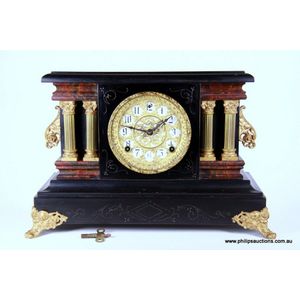Ebonised Cathedral Gong Clock by Sessions Clock Co
You must be a subscriber, and be logged in to view price and dealer details.
Subscribe Now to view actual auction price for this item
When you subscribe, you have the option of setting the currency in which to display prices to $Au, $US, $NZ or Stg.
- Faux - A French word meaning "false", but when used in decorative arts, the intention is not to deceive, but to simulate the decorative effects of the more expensive material it is imitating. The term " faux bois" meaning "false wood" refers to a furniture item that has been decorated with a marked grain (woodgrain finish) to imitate a more expensive timber.
- Embossed / Repousse - Embossing, also known as repousse, is the technique of decorating metal with raised designs, by pressing or beating out the design from the reverse side of the object.It is the opposite of chasing, where the decoration is applied from the front. An embossed or repoussed object may have chasing applied to finish off the design.
- Gilding - Gilding is a method of ornamentation whereby a thin sheet of gold metal is applied to items made of wood, leather, ceramics, glass and silver for decorative purposes.
For furniture including mirrors, the sheet of gold is usually applied over a coating of gesso. Gesso is a mixture of plaster of Paris and gypsum mixed with water and then applied to the carved wooden frames of mirrors and picture frames as a base for applying the gold leaf. After numerous coats of gesso have been applied, allowed to dry and then sanded a coat of "bole", a usually red coloured mixture of clay and glue is brushed on and allowed to dry, after which the gold leaf is applied. Over time parts of the gilding will rub off so the base colour can be seen. In water gilding, this was generally a blue colour, while in oil gilding, the under layer was often yellow. In Victorian times, gilders frequently used red as a pigment beneath the gold leaf.
Metal was often gilded by a process known as fire gilding. Gold mixed with mercury was applied and heated, causing the mercury to evaporate, the long-term effect of which was to kill or disable the craftsman or woman from mercury poisoning. The pursuit of beauty has claimed many victims, not the least of which were the artists who made those pieces so highly sought after today. - Foliate - Decorated with leaves or leaf-like forms.
This item has been included into following indexes:
Visually similar items

Vintage American wood cased mantle clock, ebonised finish, gilded dial, faux marble columns, and gilded metal handles, on gilded feet. Pendulum available. Remnants of original paper label verso. Untested. Height 32 cm approx.

Ansonia 'Venice' cast iron cased mantle clock, circa 1901 American 8 day movement, with key and pendulum, 41 cm width, 26 cm height approx

Marble mantle clock of architectural form with column support & a panel depicting a Roman battle scene, with key & pendulum. Length 46 height 40.5 cm

American ebonised mantle clock, with circular dial, set with Arabic numerals, with gilt surround, set within architectural case, flanked by columns, flanked by mask handles, raised on four scrolled feet, 28 x 41 cm
